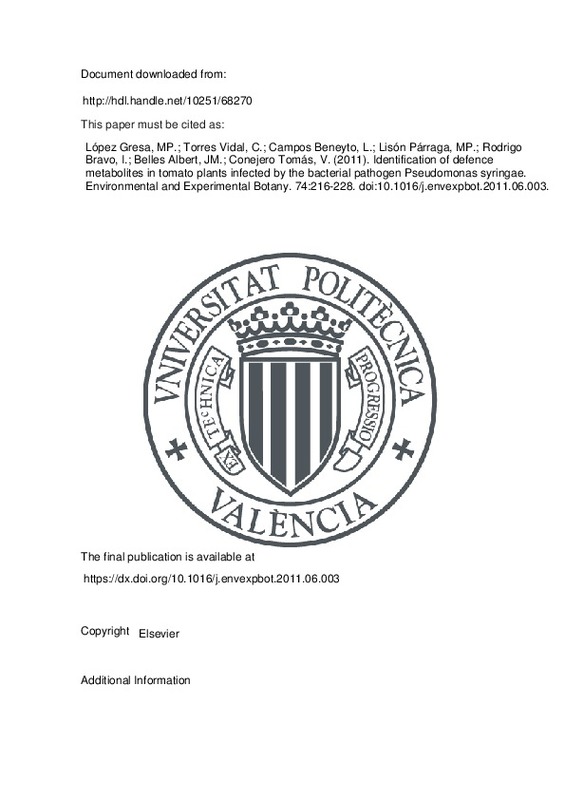JavaScript is disabled for your browser. Some features of this site may not work without it.
Buscar en RiuNet
Listar
Mi cuenta
Estadísticas
Ayuda RiuNet
Admin. UPV
Identification of defence metabolites in tomato plants infected by the bacterial pathogen Pseudomonas syringae
Mostrar el registro sencillo del ítem
Ficheros en el ítem
| dc.contributor.author | López Gresa, Mª Pilar
|
es_ES |
| dc.contributor.author | Torres Vidal, Cristina
|
es_ES |
| dc.contributor.author | Campos Beneyto, Laura
|
es_ES |
| dc.contributor.author | Lisón Párraga, María Purificación
|
es_ES |
| dc.contributor.author | Rodrigo Bravo, Ismael
|
es_ES |
| dc.contributor.author | Belles Albert, José Mª
|
es_ES |
| dc.contributor.author | Conejero Tomás, Vicente
|
es_ES |
| dc.date.accessioned | 2016-07-27T10:34:29Z | |
| dc.date.available | 2016-07-27T10:34:29Z | |
| dc.date.issued | 2011-12 | |
| dc.identifier.issn | 0098-8472 | |
| dc.identifier.uri | http://hdl.handle.net/10251/68270 | |
| dc.description.abstract | [EN] In the present work, we aimed to define the chemical nature of the phenylpropanoids induced during the interaction of the tomato plant. cultivar Rutgers, with the bacterial pathogen Pseudomonas syringae pv. tomato. Using LC-MS and NMR spectroscopy, we determined the chemical structures of this class of metabolites, which accumulated in response to exposure to the pathogen. A rapid accumulation of phytoalexin hydroxycinnamic acid amides (HCAA) of noradrenaline (cis/trans N-p-coumaroylnoradrenaline and cis/trans N-feruloylnoradrenline) and octopamine (cis/trans N-p-coumaroyloctopamine and cis/trans N-feruloyloctopamine), chlorogenic acid (CGA), and the flavonoid rutin was detected after bacterial infiltration. Among them, cis N-p-coumaroylnoradrenaline, cis N-p-coumaroyloctopamine, and isomers cis/trans of N-feruloylnoradrenaline have never been described in the literature. Moreover, cis/trans isomers of N-feruloyloctopamine are identified for the first time as being associated with the tomato/P. syringae interaction. Inhibition of the P. syringae-induced ethylene by 2-aminoethoxyvinylglycine, markedly impaired the accumulation of HCAA in inoculated tomato leaves, but it had no effect on CGA or rutin synthesis. On the other hand, the lack of accumulation of SA in NahG transgenic tomato plants, overexpressing a bacterial salicylic hydroxylase, did not prevent the enhancing of HCAA produced by P. syringae infection. Taken together, our results indicate that ethylene, but not SA, is essential for the synthesis of HCAA in response to bacterial infection of tomato leaves. Antibiotic activities of the induced metabolites were also studied. CGA induced a notable expression of the defence-related genes PR1 and P23. Moreover, trans-HCAA of noradrenaline and octopamine showed a potent free radical scavenging competence. In particular, trans N-feruloylnoradrenaline presented a very outstanding antioxidant activity, thus indicating that these compounds may play a role in the defence response of tomato plants against bacterial infection. (C) 2011 Elsevier B.V. All rights reserved. | es_ES |
| dc.description.sponsorship | The authors want to thank Dr. Lynne Yenush for critical reading of the manuscript and exciting intellectual discussions. Dominique Melck, Estrella Mateos (ICB and ITQ NMR Service) for recording NMR spectra and Letizia Ciavatta for interpretation of the 600-MHz NMR spectra. This work was supported by Grant BFU2006-11546 from Direccion General de Programas y Transferencia de Conocimiento, from Spanish Ministry of Science and Innovation. M.P.L.G. was the recipient of a postdoctoral fellowship APOSTD/2007/128 from Generalitat Valencia (Spain). | en_EN |
| dc.language | Español | es_ES |
| dc.publisher | Elsevier | es_ES |
| dc.relation.ispartof | Environmental and Experimental Botany | es_ES |
| dc.rights | Reserva de todos los derechos | es_ES |
| dc.subject | Solanum lycopersicum | es_ES |
| dc.subject | Pseudomonas syringae | es_ES |
| dc.subject | Plant metabolites | es_ES |
| dc.subject | Plant-pathogen interactions | es_ES |
| dc.subject | Hydroxycinnamic acid amides | es_ES |
| dc.subject | Free radical scavenging activity | es_ES |
| dc.subject.classification | BIOQUIMICA Y BIOLOGIA MOLECULAR | es_ES |
| dc.title | Identification of defence metabolites in tomato plants infected by the bacterial pathogen Pseudomonas syringae | es_ES |
| dc.type | Artículo | es_ES |
| dc.identifier.doi | 10.1016/j.envexpbot.2011.06.003 | |
| dc.relation.projectID | info:eu-repo/grantAgreement/MEC//BFU2006-11546/ES/ESTUDIOS SOBRE LA RESPUESTA DEFENSIVA DE LAS PLANTAS FRENTE A PATOGENOS./ | es_ES |
| dc.relation.projectID | info:eu-repo/grantAgreement/GVA//APOSTD%2F2007%2F128/ | es_ES |
| dc.rights.accessRights | Abierto | es_ES |
| dc.contributor.affiliation | Universitat Politècnica de València. Instituto Universitario Mixto de Biología Molecular y Celular de Plantas - Institut Universitari Mixt de Biologia Molecular i Cel·lular de Plantes | es_ES |
| dc.contributor.affiliation | Universitat Politècnica de València. Departamento de Biotecnología - Departament de Biotecnologia | es_ES |
| dc.description.bibliographicCitation | López Gresa, MP.; Torres Vidal, C.; Campos Beneyto, L.; Lisón Párraga, MP.; Rodrigo Bravo, I.; Belles Albert, JM.; Conejero Tomás, V. (2011). Identification of defence metabolites in tomato plants infected by the bacterial pathogen Pseudomonas syringae. Environmental and Experimental Botany. 74:216-228. https://doi.org/10.1016/j.envexpbot.2011.06.003 | es_ES |
| dc.description.accrualMethod | S | es_ES |
| dc.relation.publisherversion | https://dx.doi.org/10.1016/j.envexpbot.2011.06.003 | es_ES |
| dc.description.upvformatpinicio | 216 | es_ES |
| dc.description.upvformatpfin | 228 | es_ES |
| dc.type.version | info:eu-repo/semantics/publishedVersion | es_ES |
| dc.description.volume | 74 | es_ES |
| dc.relation.senia | 205337 | es_ES |
| dc.contributor.funder | Ministerio de Educación y Ciencia | es_ES |
| dc.contributor.funder | Generalitat Valenciana | es_ES |







![[Cerrado]](/themes/UPV/images/candado.png)

